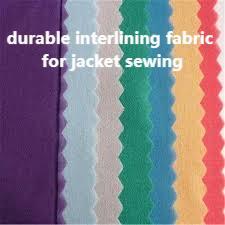In contemporary garment design, the invisible layer that gives structure and longevity is crucial; a well-chosen Interlining can refine collar crispness and stabilize lapels, and a considered Interlining selection early in development helps prevent rework while aligning appearance with laundering performance. With this foundation in mind, designers and manufacturers can make informed choices that balance hand, durability, and cost.
Why internal supports matter
Internal supports shape how a garment hangs and endures. They control stretch at stress points, keep hems from drooping, and preserve tailored silhouettes after repeated use. A garment’s perceived quality often depends more on how these unseen layers perform than on the outer fabric alone. Properly specified supports reduce distortion during cutting, sewing, and finishing and improve wearer comfort.
Types of support textiles and application methods
Support textiles appear as woven, knitted, or nonwoven constructions and can be applied by sewing, adhesive bonding, or thermal fusing. Each form and method affects handle and recovery differently. Sewn-in supports add targeted reinforcement but increase assembly steps; fused supports create a clean interior look but require precise temperature management during bonding to avoid altering the outer fabric’s appearance.
Performance factors to evaluate
Key attributes include dimensional stability, resilience through wash cycles, and compatibility with outer fabrics. Some support textiles are engineered to endure repeated dry-cleaning or high-temperature washing, while others prioritize a soft interior hand against delicate materials. Establishing realistic test protocols that reflect end-use conditions — rather than relying solely on supplier datasheets — reduces surprises during full garment trials.
Interlining-Factory collaboration and customization
Working with a specialist partner allows for tailored outcomes. Interlining-Factory provides documented validation paths and customization options that help match support behavior to design intent. Custom orders can vary in thickness, stretch, and surface finish to complement outer fabrics without changing silhouettes. When accessory formats and application guides are available, production becomes more predictable across different facilities.
Practical guidance for pattern makers and cutters
Communicate expected end-use and laundering expectations early. Narrow collars or slim lapels need thinner supports, while structured outerwear benefits from stiffer interlayers. Request prototype testing on fully assembled panels rather than isolated swatches, and document bonding parameters — temperature, pressure, and dwell time — to ensure repeatability across production shifts and factories.
Sustainability and end-of-life considerations
Material choices influence lifecycle impacts. Mono-material constructions and thermally-bonded options can simplify recycling, while reducing solvent-based adhesives lowers emissions during production. Clear labeling of internal components supports downstream recycling and encourages circular practices. Opting for durable supports that extend garment life is a practical sustainability lever.
Quality assurance and production controls
Specify measurable acceptance criteria: dimensional change after wash, peel strength of bonds, and thresholds for surface puckering. Pilot runs that include full wash cycles validate selections in real-world conditions. Insist on batch-level traceability and change-control procedures for support materials to prevent surprises during scale-up and to speed troubleshooting when issues arise.
Final recommendations and resources
Interlining decisions affect both immediate fit and long-term garment resilience. Prioritise early testing, precise specification language, and partnerships with experienced suppliers to align design intent with production realities. For more detailed guidance on types, applications, and selection strategies, consult the resource page at: https://www.interlining-factory.com/news/what-is-interlining-types-applications-and-more.html



